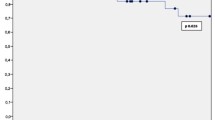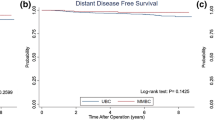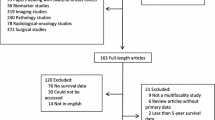Abstract
Purpose we evaluated whether patients with multifocal/multicentric (M/M) breast cancer have different outcomes compared to unifocal (U) disease in terms of survival and the development of contralateral breast cancer (CBC) disease. Methods women diagnosed with stage I–III breast cancer were classified as having U or M/M disease. Prognostic factors were prospectively collected and obtained from the breast cancer outcome unit database. Univariate and multivariable analyses for the incidence of CBC were performed as well as Kaplan–Meier plots. Results 25,320 women met inclusion criteria. The 5-year cumulative incidence of CBC in the U versus M/M group was 2.3% (95% CI 2.1, 2.5) versus 2.4% (95% CI 1.6, 3.4) (P = 0.349). Breast cancer specific survival (BCSS) rate revealed a slightly worse outcome with M/M disease, RR = 1.174 (95% CI 1,004, 1.372). Conclusions M/M breast cancer did not increase the risk of metachronous CBC, but was associated with inferior BCSS.



Similar content being viewed by others
References
Early Breast Cancer Trialists’ Collaborative Group (EBCTCG) (2005) Effects of chemotherapy and hormonal therapy for early breast cancer on recurrence and 15-year survival: an overview of the randomized trials. Lancet 365:1687–1717
Fracchia AA, Borgen PI (1991) Bilateral breast cancer. Semin Surg Oncol 7:300–305. doi:10.1002/ssu.2980070513
Newman LA, Sahin AA, Cunningham JE (2001) Case-control study of unilateral and bilateral breast carcinoma patients. Cancer 91:1845–1853. doi:10.1002/1097-0142(20010515)91:10<1845::AID-CNCR1205>3.0.CO;2-Z
Dawson PJ (1996) Bilateral and multifocal breast cancer. Cancer Control 3:258–266
Olivotto IA, Mates D, Kan L et al (1999) Prognosis, treatment, and recurrence of breast cancer for women attending or not attending the screening mammography program of British Columbia. Breast Cancer Res Treat 54:73–81. doi:10.1023/A:1006152918283
Scrucca L, Santucci A, Aversa F (1999) Competing risk analysis using R: an easy guide for clinicians. Bone Marrow Transplant 40:381–387. doi:10.1038/sj.bmt.1705727
Satagopan JM, Ben-Porat L, Berwick M (2004) A note on competing risks in survival data analysis. Br J Cancer 91:1229–1235. doi:10.1038/sj.bjc.6602102
Robson ME, Chappuis PO, Satagopan J (2004) A combined analysis of outcome following breast cancer: differences in survival based on BRCA1/BRCA2 mutation status and administration of adjuvant treatment. Breast Cancer Res 6:R8–R17. doi:10.1186/bcr658
Kim HT (2007) Cumulative incidence in competing risks data and competing risks regression analysis. Clin Cancer Res 13:559–565. doi:10.1158/1078-0432.CCR-06-1210
Gray RJ (1988) Class of K-sample tests for comparing the cumulative incidence of a competing risk. Ann Stat 16:1141–1154. doi:10.1214/aos/1176350951
Fine JP, Gray RJ (1999) Proportional hazards model for the subdistribution of a competing risk. J Am Stat Assoc 94:496–509. doi:10.2307/2670170
Bertelsen L, Bernstein L, Olsen JH et al (2008) Effect of systemic adjuvant treatment on risk for contralateral breast cancer in the women’s environment, cancer and radiation epidemiology study. J Natl Cancer Inst 100:32–40. doi:10.1093/jnci/djm267
Coombs NJ, Boyages J (2005) Multifocal and multicentric breast cancer: does each focus matter? J Clin Oncol 23:7497–7502. doi:10.1200/JCO.2005.02.1147
Schaapveld M, Visser O, Louwman WJ (2007) The impact of adjuvant therapy on contralateral breast cancer risk and the prognostic significance of contralateral breast cancer: a population based study in the Netherlands. Breast Cancer Res Treat 110:189–197. doi:10.1007/s10549-007-9709-2
Kuo WH, Yen AM, Lee PH (2006) Incidence and risk factors associated with bilateral breast cancer in area with early age diagnosis but low incidence of primary breast cancer: analysis of 10-year longitudinal cohort in Taiwan. Breast Cancer Res Treat 99:221–228. doi:10.1007/s10549-006-9194-z
Fowble B, Hanlon A, Freedman G et al (2001) Second cancers after conservative surgery and radiation for stages I–II breast cancer: identifying a subset of women at increased risk. Int J Radiat Oncol Biol Phys 51:679–690. doi:10.1016/S0360-3016(01)01665-0
Gajalakshmi CK, Shanta V, Hakama M (1998) Risk factors for contralateral breast cancer in Chennai (Madras), India. Int J Epidemiol 27:743–750. doi:10.1093/ije/27.5.743
Broet P, de la Rochefordiere A, Scholl SM (1995) Contralateral breast cancer: annual incidence and risk parameters. J Clin Oncol 13:1578–1583
Bernstein JL, Thompson WD, Risch N et al (1992) Risk factors predicting the incidence of second primary breast cancer among women diagnosed with a first primary breast cancer. Am J Epidemiol 136:925–936
Kollias J, Ellis IO, Elston CW et al (2001) Prognostic significance of synchronous and metachronous bilateral breast cancer. World J Surg 25:1117–1124
Fechner RE (1972) Infiltrating lobular carcinoma without lobular carcinoma in situ. Cancer 29:1539–1545
du Toit RS, Locker AP, Ellis IO et al (1989) Invasive lobular carcinomas of the breast—the prognosis of histopathological subtypes. Br J Cancer 60:605–609
DiCostanzo D, Rosen PP, Gareen I et al (1990) Prognosis in infiltrating lobular carcinoma. An analysis of “classical” and variant tumors. Am J Surg Pathol 14:12–23. doi:10.1097/00000478-199001000-00002
Ji J, Hemminki K (2007) Risk for contralateral breast cancers in a population covered by mammography: effects of family history, age at diagnosis and histology. Breast Cancer Res Treat 105:229–236. doi:10.1007/s10549-006-9445-z
Chen AM, Meric-Bernstam F, Hunt KK et al (2005) Breast conservation after neoadjuvant chemotherapy. Cancer 103:689–695. doi:10.1002/cncr.20815
Chua B, Ung O, Taylor R et al (2001) Frequency and predictors of axillary lymph node metastases in invasive breast cancer. ANZ J Surg 71:723–728. doi:10.1046/j.1445-1433.2001.02266.x
Andea AA, Bouwman D, Wallis T et al (2004) Correlation of tumor volume and surface area with lymph node status in patients with multifocal/multicentric breast carcinoma. Cancer 100:20–27. doi:10.1002/cncr.11880
Andea AA, Wallis T, Newman LA et al (2002) Pathologic analysis of tumor size and lymph node status in multifocal/multicentric breast carcinoma. Cancer 94:1383–1390
Litton JK, Eralp Y, Gonzalez-Angulo AM et al (2007) Multifocal breast cancer in women ≤35 years old. Cancer 110:1445–1450. doi:10.1002/cncr.22928
Author information
Authors and Affiliations
Corresponding author
Rights and permissions
About this article
Cite this article
Yerushalmi, R., Kennecke, H., Woods, R. et al. Does multicentric/multifocal breast cancer differ from unifocal breast cancer? An analysis of survival and contralateral breast cancer incidence. Breast Cancer Res Treat 117, 365–370 (2009). https://doi.org/10.1007/s10549-008-0265-1
Received:
Accepted:
Published:
Issue Date:
DOI: https://doi.org/10.1007/s10549-008-0265-1




